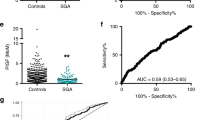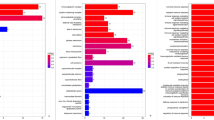Abstract
To determine if circulating levels of maternal syndecan-1, a part of the endothelial glycocalyx, change over gestational weeks 11–13 and if first trimester serum syndecan-1 levels are aberrant in women with adverse pregnancy outcomes vs. controls. Dried blood samples from 300 randomly selected women (100 each from gestational weeks 11, 12, and 13) who delivered at Northwell Health were assessed for syndecan-1 levels. Subjects were segregated by gestational age and maternal weight at the time of blood draw. Gestational age-specific medians were determined by linear regression of median syndecan-1 values vs. gestational age. Multiples of the median (MoMs) = syndecan-1/respective gestational age-specific regressed median. After determining a normal range, we performed a case-control study. Cases (n = 119) were singleton pregnancies with preeclampsia or fetal growth restriction who delivered at 20–36 6/7 weeks with 1st trimester conventional aneuploidy screens; 2 controls (n = 238) per case were identified and assessed. Syndecan-1 levels were determined by ELISA. Data were reported as MoMs and analyzed based on Wilcoxon rank-sum test and Fisher’s exact test. A progressive and significant increase in median circulating Sdc1 concentrations was observed from gestational weeks 11–13 (p < 0.001). There was no significant difference in median syndecan-1 MoM values among cases and controls (p = 0.22). However, a subgroup of cases (17.6%) had extreme syndecan-1 values (≤ 0.5MoM) vs. 6.7% of controls (p = 0.003, OR = 3.0). Serum syndecan-1 concentrations significantly increase during gestational weeks 11–13. Extremely low 1st trimester serum syndecan-1 values are associated with an increased risk of adverse pregnancy outcome.



Similar content being viewed by others
References
van Esch JJA, van Heijst AF, de Haan AFJ, van der Heijden OWH. Early-onset preeclampsia is associated with perinatal mortality and severe neonatal morbidity. J Matern Fetal Neonatal Med. 2017;30:2789–94.
Main EK. Maternal mortality: new strategies for measurement and prevention. Curr Opin Obstet Gynecol. 2010;22:511–6.
van der Post JA, Lok CA, Boer K, Sturk A, Sargent IL, Nieuwland R. The functions of microparticles in pre-eclampsia. Semin Thromb Hemost. 2011;37:146–52.
Roberts JM, Escudero C. The placenta in preeclampsia. Pregnancy Hypertens. 2012;2:72–83.
Sibai B, Dekker G, Kupferminc M. Pre-eclampsia. Lancet. 2005;365:785–99.
Levine RJ, Maynard SE, Qian C, Lim KH, England LJ, Yu KF, et al. Circulating angiogenic factors and the risk of preeclampsia. N Engl J Med. 2004;350:672–83.
Su EJ. Role of the fetoplacental endothelium in fetal growth restriction with abnormal umbilical artery Doppler velocimetry. Am J Obstet Gynecol. 2015;213:S123–30.
Lyall F, Bulmer JN, Duffie E, Cousins F, Theriault A, Robson SC. Human trophoblast invasion and spiral artery transformation: the role of PECAM-1 in normal pregnancy, preeclampsia, and fetal growth restriction. Am J Pathol. 2001;158:1713–21.
Kaufmann P, Black S, Huppertz B. Endovascular trophoblast invasion: implications for the pathogenesis of intrauterine growth retardation and preeclampsia. Biol Reprod. 2003;69:1–7.
Poon LC, McIntyre HD, Hyett JA, da Fonseca EB, Hod M, Pregnancy F, et al. The first-trimester of pregnancy - a window of opportunity for prediction and prevention of pregnancy complications and future life. Diabetes Res Clin Pract. 2018;145:20–30.
Kane SC, Costa Fda S, Brennecke S. First trimester biomarkers in the prediction of later pregnancy complications. Biomed Res Int. 2014;2014:807196.
ACOG Committee Opinion No. 743: Low-dose aspirin use during pregnancy. Obstet Gynecol. 2018;132:e44–52.
Couchman JR. Syndecans: proteoglycan regulators of cell-surface microdomains? Nat Rev Mol Cell Biol. 2003;4:926–37.
Alexopoulou AN, Multhaupt HA, Couchman JR. Syndecans in wound healing, inflammation and vascular biology. Int J Biochem Cell Biol. 2007;39:505–28.
Jokimaa V, Inki P, Kujari H, Hirvonen O, Ekholm E, Anttila L. Expression of syndecan-1 in human placenta and decidua. Placenta. 1998;19:157–63.
Schmedt A, Gotte M, Heinig J, Kiesel L, Klockenbusch W, Steinhard J. Evaluation of placental syndecan-1 expression in early pregnancy as a predictive fetal factor for pregnancy outcome. Prenat Diagn. 2012;32:131–7.
Gandley RE, Althouse A, Jeyabalan A, Bregand-White JM, McGonigal S, Myerski AC, et al. Low soluble syndecan-1 precedes preeclampsia. PLoS One. 2016;11:e0157608.
Heyer-Chauhan N, Ovbude IJ, Hills AA, Sullivan MH, Hills FA. Placental syndecan-1 and sulphated glycosaminoglycans are decreased in preeclampsia. J Perinat Med. 2014;42:329–38.
Johansson PI, Stensballe J, Rasmussen LS, Ostrowski SR. A high admission syndecan-1 level, a marker of endothelial glycocalyx degradation, is associated with inflammation, protein C depletion, fibrinolysis, and increased mortality in trauma patients. Ann Surg. 2011;254:194–200.
Rahbar E, Cardenas JC, Baimukanova G, Usadi B, Bruhn R, Pati S, et al. Endothelial glycocalyx shedding and vascular permeability in severely injured trauma patients. J Transl Med. 2015;13:117.
American College of Obstetricians and Gynecologists, Task Force on Hypertension in Pregnancy: Hypertension in pregnancy. Report of the American College of Obstetricians and Gynecologists’ Task Force on Hypertension in Pregnancy. Obstet Gynecol. 2013;122:1122–31.
Poon LC, Stratieva V, Piras S, Piri S, Nicolaides KH. Hypertensive disorders in pregnancy: combined screening by uterine artery Doppler, blood pressure and serum PAPP-A at 11-13 weeks. Prenat Diagn. 2010;30:216–23.
O’Gorman N, Wright D, Poon LC, Rolnik DL, Syngelaki A, de Alvarado M, et al. Multicenter screening for pre-eclampsia by maternal factors and biomarkers at 11-13 weeks’ gestation: comparison with NICE guidelines and ACOG recommendations. Ultrasound Obstet Gynecol. 2017;49:756–60.
Dugoff L, Hobbins JC, Malone FD, Vidaver J, Sullivan L, Canick JA, et al. Quad screen as a predictor of adverse pregnancy outcome. Obstet Gynecol. 2005;106:260–7.
Gallo DM, Wright D, Casanova C, Campanero M, Nicolaides KH. Competing risks model in screening for preeclampsia by maternal factors and biomarkers at 19-24 weeks’ gestation. Am J Obstet Gynecol. 2016;214:619 e1–e17.
Baston-Bust DM, Gotte M, Janni W, Krussel JS, Hess AP. Syndecan-1 knock-down in decidualized human endometrial stromal cells leads to significant changes in cytokine and angiogenic factor expression patterns. Reprod Biol Endocrinol. 2010;8:133.
Jokimaa VI, Kujari HP, Ekholm EM, Inki PL, Anttila L. Placental expression of syndecan 1 is diminished in preeclampsia. Am J Obstet Gynecol. 2000;183:1495–8.
Chui A, Zainuddin N, Rajaraman G, Murthi P, Brennecke SP, Ignjatovic V, et al. Placental syndecan expression is altered in human idiopathic fetal growth restriction. Am J Pathol. 2012;180:693–702.
Gotte M. Syndecans in inflammation. FASEB J. 2003;17:575–91.
Steppan J, Hofer S, Funke B, Brenner T, Henrich M, Martin E, et al. Sepsis and major abdominal surgery lead to flaking of the endothelial glycocalix. J Surg Res. 2011;165:136–41.
Szabo S, Xu Y, Romero R, Fule T, Karaszi K, Bhatti G, et al. Changes of placental syndecan-1 expression in preeclampsia and HELLP syndrome. Virchows Arch. 2013;463:445–58.
Hofmann-Kiefer KF, Knabl J, Martinoff N, Schiessl B, Conzen P, Rehm M, et al. Increased serum concentrations of circulating glycocalyx components in HELLP syndrome compared to healthy pregnancy: an observational study. Reprod Sci. 2013;20:318–25.
Kwon MJ, Jang B, Yi JY, Han IO, Oh ES. Syndecans play dual roles as cell adhesion receptors and docking receptors. FEBS Lett. 2012;586:2207–11.
Nikolova V, Koo CY, Ibrahim SA, Wang Z, Spillmann D, Dreier R, et al. Differential roles for membrane-bound and soluble syndecan-1 (CD138) in breast cancer progression. Carcinogenesis. 2009;30:397–407.
Maynard SE, Crawford SL, Bathgate S, Yan J, Robidoux L, Moore M, et al. Gestational angiogenic biomarker patterns in high risk preeclampsia groups. Am J Obstet Gynecol. 2013;209:53 e1–9.
Acknowledgements
The authors thank Dr. Kelecia Brown and Dr. Adiel Fleischer for suggesting this topic for investigation and Dr. Meir Greenberg for his assistance in searching the Northwell Health patient database. We thank Dr. Paola Di Marzio for contributing to the study design.
Funding
The study was financially supported by the Feinstein Institutes for Medical Research and NTD Labs (which only purchased the syndecan-1 ELISA kits, which were run by Northwell Health employees).
Author information
Authors and Affiliations
Corresponding author
Ethics declarations
Conflict of Interest
DAK and JBC are employees of Eurofins NTD, LLC. The remaining authors, ETG, BR, XX, SA, SW, SA, and CNM, report no conflict of interest.
Research Ethics
This study was approved by the Northwell Health Office of the Human Research Protection Program (IRB no. 14-340B).
Additional information
Research was completed at the Feinstein Institutes for Medical Research, Manhasset, NY.
Rights and permissions
About this article
Cite this article
Greeley, E.T., Rochelson, B., Krantz, D.A. et al. Evaluation of Syndecan-1 as a Novel Biomarker for Adverse Pregnancy Outcomes. Reprod. Sci. 27, 355–363 (2020). https://doi.org/10.1007/s43032-019-00032-5
Received:
Accepted:
Published:
Issue Date:
DOI: https://doi.org/10.1007/s43032-019-00032-5




